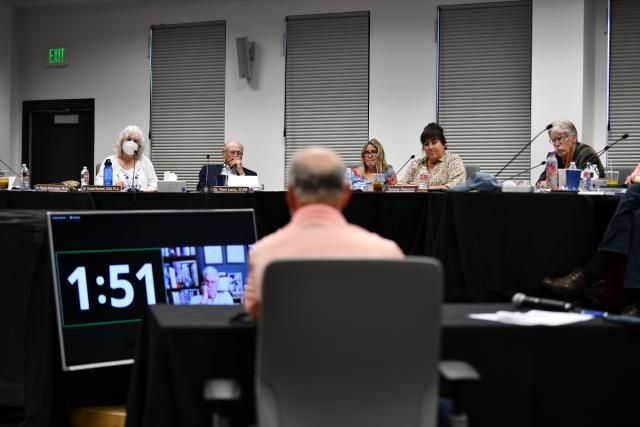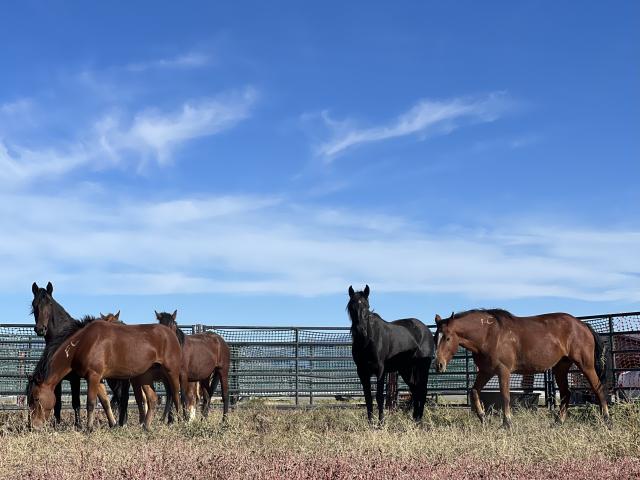Myths and facts about motorized vehicle use in managing wild horses and burros
Public involvement is a cornerstone of the Bureau of Land Management’s Wild Horse and Burro Program. The BLM regularly invites members of the public to share their perspectives on how the agency manages wild horses and burros on public lands, including through environmental analysis processes, at public hearings, and at public meetings of the Advisory Board. The BLM takes public input seriously, using it to inform decision-making and improve transparency around complex management issues.
On May 6, 2025, the BLM held its annual public hearing on the use of motorized vehicles in the management of wild horses and burros. The hearing was an opportunity for members of the public to share their views with BLM Wild Horse and Burro Program leads from BLM headquarters and state offices across the country.
The hearing drew strong public interest, with many participants registering to share comments on how the BLM uses motorized vehicles in wild horse and burro management, such as using helicopters (and other vehicles) during gathers. In addition to the oral comments the BLM heard at the hearing, the BLM also received thousands of written comments.
The comments below paraphrase some of the more frequently raised issues from the public in the 2025 hearing. Just below each comment is some information that the BLM hopes will provide additional context and clarity. The BLM acknowledges many comments provided more specific recommendations, and while the agency does not intend for this summary information to fully address all of the public’s comments and concerns, each comment is read and evaluated by the BLM.
The BLM sincerely appreciates the time and thought many in the public put into their comments.
The BLM does not listen to the public’s feedback or recognize any public comments made during previous motor vehicle use hearings.

The hearing is not part of the BLM’s analysis of any single, site-specific action. The BLM does not respond to public comments from the hearing in the same way that it does to public comments that are part of National Environmental Policy Act analyses of particular wild horse and burro management alternatives. However, the public’s comments about motor vehicle use are greatly appreciated and they help inform the BLM’s policies and practices overall. Every comment delivered at the hearing or received by email is evaluated and considered by the BLM. Official minutes from the last several years of the virtual hearings have been published on the BLM’s website.
In addition to the annual hearing on motorized vehicle use, there are many ways the public can provide constructive feedback to the BLM. For example, the BLM routinely accepts public comments for environmental assessments through the National Environmental Policy Act process, including on assessments of specific wild horse and burro gather plans, fertility control treatments and other actions. The public may find information on environmental assessments on the BLM’s website, and on the BLM’s NEPA Register.
The BLM also relies on advice and guidance from the citizen-based National Wild Horse and Burro Advisory Board. Instructions for contacting the Board or becoming a board member can be found on the Advisory Board webpage. The Board typically meets once or twice every year, and each meeting typically provides multiple opportunities when the public can provide written and oral comments for the Board to consider when they draft recommendations to the BLM.
Finally, the BLM staffs a Wild Horse and Burro National Information Center that is available for the public during normal business hours. The public can request information and give feedback by contacting the information center. To contact the information center, please call 866-468-7826 or email [email protected].
It is illegal for the BLM to use helicopters in wild horse management. The BLM’s use of helicopters to gather animals is inhumane, and the BLM routinely violates its own animal welfare standards. For example, the health of pregnant mares and foals is not considered during helicopter gathers.
The BLM cares deeply about the wild horses and burros under our care and management. The BLM deliberates seriously before any wild horse or burro operation, and only removes animals when it is required by law. In the Wild Free-Roaming Horses and Burros Act, Congress directs the federal government to remove wild horses and burros when a private landowner asks that they be removed from their land or when there are so many horses or burros on public lands that they jeopardize the thriving natural ecological balance.
The BLM takes humane handling and care very seriously. To ensure the BLM is always providing humane care, the agency holds itself to welfare standards that were developed in collaboration with external animal welfare experts through the Comprehensive Animal Welfare Program. These humane welfare standards apply to all wild horse and burro gathers, and include guidelines on things such as the speed at which wild horses and burros are gathered, limitations on gather activities based on extreme weather conditions, and requirements on post-gather care at holding facilities. For example, the Comprehensive Animal Welfare Program requires that a group of animals may not be moved faster than appropriate for the slowest animals in the group – such as a foal or pregnant mare. Other requirements include quickly reuniting mares and their dependent foals (if they become separated), and limits on gathering in excessive heat (warmer than 95 degrees F) and cold weather (less than 15 degrees F).
Even before the BLM adopted the Comprehensive Animal Welfare Policy in 2015, several independent reviews confirmed that the BLM’s gathers using helicopters are humane, such as the review by the American Association of Equine Practitioners.
Adherence to the Comprehensive Animal Welfare Program, as well as annual training, is required of all BLM staff, volunteers, partners and contractors. The BLM oversees helicopter gather operations and contractors are required to follow these standards. The BLM completes assessments conducted by an interdisciplinary team of specialists from other offices to document and track compliance with the welfare standards. A non-BLM veterinarian is present at helicopter gathers to provide additional oversite and further ensure the health and well-being of the wild horses and burros.
An independent analysis summarized gather results from 2010-2019 and showed that the average mortality rate directly caused by BLM gathers (called “acute” mortality in that paper) was about 1 in 300 animals captured, which is far lower than most large wildlife capture operations. Losses from helicopter-assisted gather operations in recent years remain very low – about one-half of one percent of the animals gathered, on average.
The Comprehensive Animal Welfare Program and the BLM’s standard operating procedures for gathering wild horses and burros are constantly re-evaluated based on feedback and actual results in the field.
Gathers are unnecessary. The BLM should prioritize fertility control over helicopter-assisted gathers

The BLM appreciates the public’s support for continued and expanded use of safe and humane fertility control methods to slow herd growth and reduce the need for removing animals for adoption. Fertility control is an important management tool that can help maintain healthy population levels and protect rangeland resources important to wild horses, wild burros, and other wildlife and authorized uses of the land.
As of March 2025, the total estimated wild horse and burro population on BLM-managed public lands was approximately 73,130 animals – more than two and half times the target population of 26,556 animals that is healthy and sustainable for the land and the herds. Chronic overpopulation damages important resources on public lands, such as fragile springs and other water sources, and fosters the spread of invasive weeds that are less nutritious for wildlife and exacerbate threat of wildfire. Though various fertility control methods can help slow herd growth, they are not effective at reducing an overpopulation that is already present in the short term.
There is a publicly available modeling program called "PopEquus" which anyone can use to compare the population and cost outcomes of whatever mix of starting population size, fertility control application rates, and removals they want to try. Even in the few places where fertility control alone has reduced wild horse populations (such as Assateague Island in the eastern USA), it requires very frequent access to nearly every mare in the herd, which is costly, and it can take many years until a herd begins to decline in size.
In contrast to small barrier islands of the east coast, many BLM-managed wild horse and burro herds roam large, rugged terrain where roads are few and rough, and mares are not approachable for frequent darting.
BLM
Related Stories
- Using science to uncover mysteries of the Mesa archaeological site in Alaska
- “Where did my horse come from?” BLM launches a new way for adopters, trainers and others to learn about their wild horses and burros
- Lake Havasu Fisheries Improvement Program is the gift that keeps giving
- BLM is thankful for public lands volunteers
- BLM delivers on administration priorities
